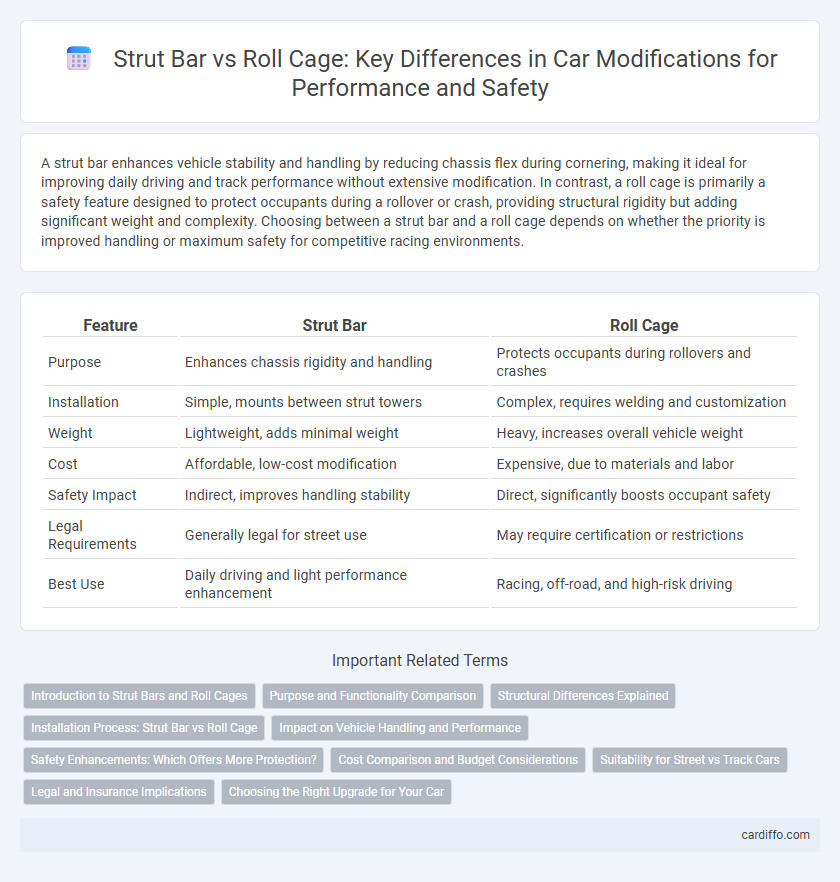A strut bar enhances vehicle stability and handling by reducing chassis flex during cornering, making it ideal for improving daily driving and track performance without extensive modification. In contrast, a roll cage is primarily a safety feature designed to protect occupants during a rollover or crash, providing structural rigidity but adding significant weight and complexity. Choosing between a strut bar and a roll cage depends on whether the priority is improved handling or maximum safety for competitive racing environments.
Table of Comparison
| Feature | Strut Bar | Roll Cage |
|---|---|---|
| Purpose | Enhances chassis rigidity and handling | Protects occupants during rollovers and crashes |
| Installation | Simple, mounts between strut towers | Complex, requires welding and customization |
| Weight | Lightweight, adds minimal weight | Heavy, increases overall vehicle weight |
| Cost | Affordable, low-cost modification | Expensive, due to materials and labor |
| Safety Impact | Indirect, improves handling stability | Direct, significantly boosts occupant safety |
| Legal Requirements | Generally legal for street use | May require certification or restrictions |
| Best Use | Daily driving and light performance enhancement | Racing, off-road, and high-risk driving |
Introduction to Strut Bars and Roll Cages
Strut bars are rigid components installed between the tops of a vehicle's suspension struts to reduce chassis flex and improve handling during cornering. Roll cages are internal metal frameworks designed to protect occupants by reinforcing the vehicle's structural integrity in the event of a rollover or crash. Both serve distinct roles in vehicle modification, with strut bars enhancing performance and roll cages prioritizing safety.
Purpose and Functionality Comparison
Strut bars enhance chassis rigidity by connecting the strut towers to reduce flex during cornering, improving handling precision and stability for everyday street driving. Roll cages provide comprehensive structural reinforcement designed to protect occupants during high-impact collisions and rollovers, making them essential for motorsport safety compliance. While strut bars focus on performance enhancement, roll cages prioritize occupant safety and chassis integrity under extreme racing conditions.
Structural Differences Explained
Strut bars reinforce the vehicle's chassis by connecting the tops of the suspension struts, reducing flex during cornering and improving handling. Roll cages offer comprehensive structural support, creating a protective framework inside the cabin that enhances rigidity and safety in high-impact situations. While strut bars mainly enhance suspension stiffness, roll cages significantly increase overall chassis strength and occupant protection.
Installation Process: Strut Bar vs Roll Cage
Strut bars feature a straightforward installation process, typically requiring only basic tools to mount between the strut towers, minimizing time and complexity. Roll cage installation demands extensive modifications, including welding and structural reinforcement, often necessitating professional expertise and significant vehicle disassembly. The complexity and duration of installing a roll cage contrast sharply with the plug-and-play nature of strut bars, reflecting their different roles in chassis stiffness and safety.
Impact on Vehicle Handling and Performance
Strut bars enhance vehicle handling by increasing chassis rigidity, reducing body flex during cornering, and improving steering response without adding significant weight. Roll cages, while primarily designed for safety, significantly stiffen the chassis and can drastically improve handling by minimizing torsional flex, especially in high-performance and track vehicles. The added weight and complexity of roll cages may slightly reduce acceleration and fuel efficiency, but their impact on overall performance and driver confidence often outweighs these drawbacks in competitive driving scenarios.
Safety Enhancements: Which Offers More Protection?
Roll cages provide superior safety enhancements compared to strut bars by offering comprehensive structural reinforcement throughout the vehicle's cabin, significantly reducing deformation during a rollover or collision. Strut bars mainly improve chassis rigidity and handling but do not provide direct impact protection for occupants. For maximum occupant safety in motorsports or high-risk driving conditions, roll cages are the preferred modification.
Cost Comparison and Budget Considerations
Strut bars provide a cost-effective suspension upgrade, typically priced between $100 and $300, making them ideal for budget-conscious enthusiasts seeking improved handling. Roll cages involve significantly higher expenses, often ranging from $1,000 to $5,000 depending on materials and complexity, reflecting their comprehensive safety enhancement role. Budget considerations should weigh the strut bar's affordability and ease of installation against the roll cage's extensive protection and potential insurance benefits.
Suitability for Street vs Track Cars
Strut bars enhance chassis rigidity and improve handling primarily for street cars by reducing flex during everyday driving without compromising comfort. Roll cages provide superior structural reinforcement designed for track cars, offering maximum safety and stiffness but can be impractical for daily street use due to weight and cabin intrusion. Choosing between a strut bar and roll cage depends on whether the vehicle is intended for street driving or competitive track performance.
Legal and Insurance Implications
Strut bars are generally legal for street use and often pose no issues with insurance policies as they are considered minor suspension modifications. Roll cages, while enhancing safety for racing, may be illegal for street vehicles in some regions due to rigid structural changes that can affect crash safety standards and occupant egress. Insurance companies may increase premiums or deny coverage if a roll cage is installed in a non-racing vehicle, reflecting higher perceived risk and repair costs.
Choosing the Right Upgrade for Your Car
When deciding between a strut bar and a roll cage for car modification, focus on your driving needs and safety goals. A strut bar enhances chassis rigidity and improves handling, particularly beneficial for street and track enthusiasts seeking better cornering performance. In contrast, a roll cage provides comprehensive structural protection during high-impact crashes, making it essential for competitive racing and extreme performance applications where driver safety is paramount.
Strut Bar vs Roll Cage Infographic

 cardiffo.com
cardiffo.com